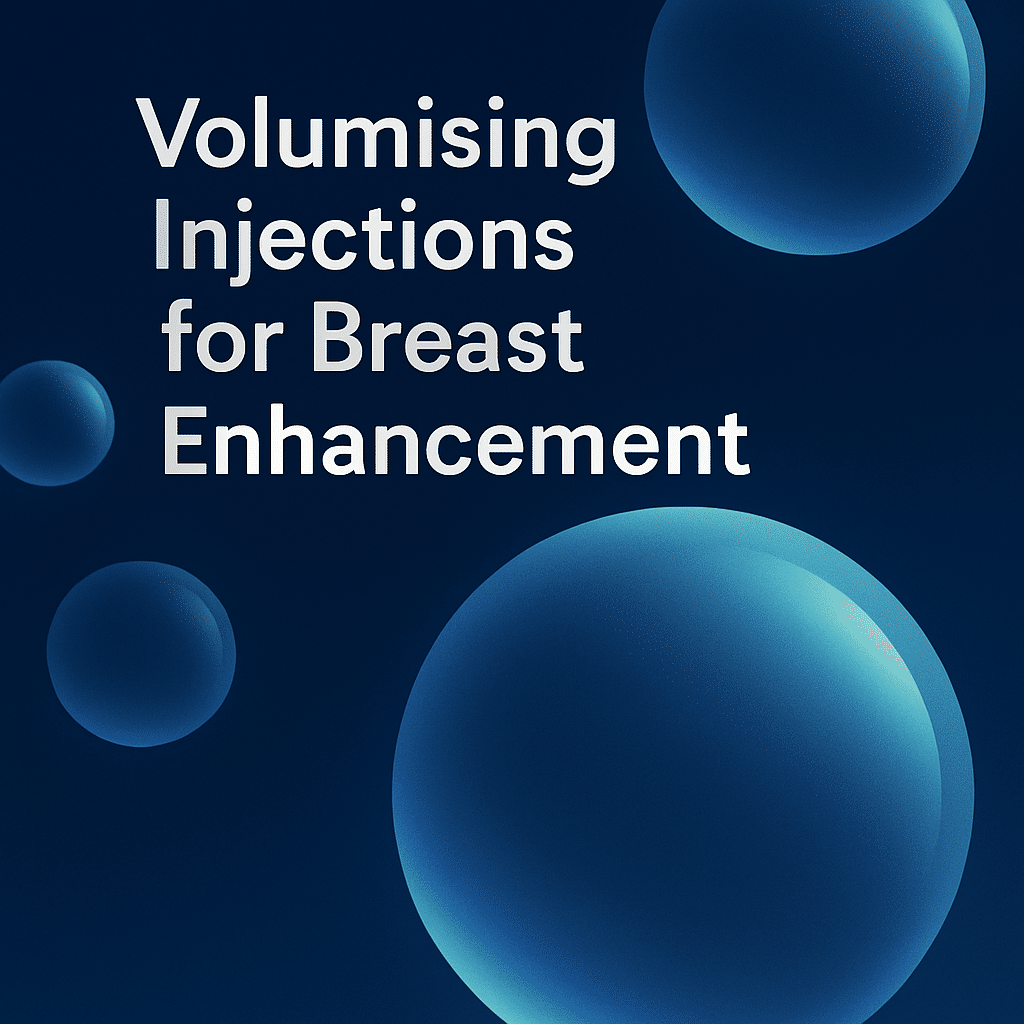Volumising Injections for Breast Enhancement — New Frontier or Past Mistakes Revisited?
Expert opinion • Santi London • Evidence-led aesthetics
Minimally invasive “liquid” breast enhancement is being talked about again. Before anyone books in, let’s examine the evidence, the history, the real-world risks, and who (if anyone) may be a candidate — with Santi’s safety-first perspective.
What do we mean by volumising injections?
“Volumising injections” covers several approaches aimed at increasing breast volume without traditional implants:
- Large-volume soft-tissue fillers (e.g., hyaluronic acid gels used off-label in much bigger quantities than facial aesthetics).
- Autologous fat transfer (lipofilling) — fat is harvested via liposuction and reinjected into the breast. Not strictly a “filler”, but a minimally invasive volumising technique.
- Adjunct or experimental methods — e.g., external expansion devices, processing/enrichment of fat, and various “next-gen” gels touted for longer duration.
A short history: Macrolane & why it was paused
In the 2000s, Q-Med introduced Macrolane, a hyaluronic acid (HA) gel for body contouring that some clinics used for breast augmentation. It was promoted as a breakthrough “no-implant” solution. However, concerns emerged:
Interference with screening
Injected gel could distort mammograms or mimic lesions, making early cancer detection more difficult and anxiety-provoking.
Complications & unpredictability
Reports included infection, migration, nodules, and uneven resorption. Revision can be complex, especially after large volumes.
Ultimately, Macrolane was withdrawn for breast use in many markets, becoming a cautionary tale: innovation without long-term data can leave patients exposed.
What’s “new” today — and what isn’t
Modern marketing suggests a safer “new wave”. In practice, progress is mixed:
- Fat transfer has matured in technique and patient selection, but typical gains are modest (often around half to one cup size), and fat survival varies.
- Processing/enrichment aims to improve graft take; costs and evidence quality vary. Stem-cell-language often outpaces regulation and consensus.
- “Next-generation fillers” claim longer duration or better imaging profiles, but independent, long-horizon safety data remain limited — especially at the volumes used for breasts.
Potential advantages
- Less invasive than implants; shorter recovery and fewer obvious scars.
- Softer, subtle results, particularly with well-performed fat transfer.
- Staged change — some patients prefer a gradual, conservative increase.
- Avoiding an implant may suit those who dislike foreign-body devices.
Key risks, limits & unknowns
- Imaging interference: Fillers and fat can create densities, cysts or calcifications that complicate mammography and ultrasound. Clear communication with breast-imaging teams is essential.
- Complications: Infection, migration, nodules, fat necrosis, oil cysts — and the challenge of reversing a large-volume injection if you’re unhappy.
- Limited, variable volume: Predictable, significant size increases are difficult without implants; fat survival can be inconsistent.
- Maintenance & cost: HA-type gels resorb; fat may partially reabsorb; repeat sessions increase lifetime cost and risk exposure.
- Regulatory status: Many “liquid boob job” offerings rely on off-label use; evidence is patchy and often industry-led.
Who might consider it?
Very selective candidates may include people who:
- want a modest increase and accept variability;
- prefer to avoid implants and are comfortable with possible repeat treatments;
- are suitable for fat harvest and are counselled about fat-related imaging changes;
- can be followed by teams experienced in breast imaging and post-procedure care.
Suitability hinges on medical history, breast screening needs, desired volume, tissue quality, and risk tolerance. Decisions should be made with a GMC-registered, FRCS(Plast) plastic surgeon.
Alternatives to consider
- Breast implants (saline/silicone) — most predictable for meaningful size change; known device lifecycle and screening protocols.
- Fat transfer (by a specialist) — softer feel, subtle volume; requires realistic expectations and imaging-aware follow-up.
- Non-surgical shaping — posture, bra fittings, strength training for pectorals (cosmetic contour benefit; no tissue volume change).
Considering options? We can help you make sense of claims and risks before you see a surgeon.
Book an evidence-led consultation
Independent guidance • Risk-benefit clarity • Referral to appropriate specialists where helpful
Santi’s view
We welcome innovation, but our stance is simple: safety before novelty. Large-volume injections into breast tissue remain an area of heightened caution. Until long-term, independent data demonstrate stable volume, low complication rates, and clean imaging, we view volumising injections for breast enhancement as experimental, not mainstream.
If you’re curious about subtle enhancement, a surgeon-led fat transfer discussion may be appropriate — with eyes wide open about variability and imaging. For larger, reliable volume changes, implants remain the best-studied route.

Frequently asked questions
Are “liquid boob jobs” approved in the UK?
There’s no single, MHRA-approved breast “filler” for large-volume augmentation. Many offerings rely on off-label product use. Always ask exactly what is being injected and whether it’s approved for that indication.
Will injections affect my breast screening?
They can. Both fillers and fat transfer may alter mammograms or ultrasound appearance. You’ll need imaging teams aware of your history and, in some cases, additional views or modalities.
How much volume can I realistically expect?
For fat transfer, think subtle changes — often around half to one cup size, sometimes more over staged sessions. Fillers may create visible change short-term but bring cost/maintenance and safety considerations.
What are the main complications?
Infection, nodules, migration (fillers), fat necrosis and oil cysts (fat transfer), imaging artefacts, asymmetry, and the possibility of needing revision. Removal of large-volume gel can be difficult.
Who is the right clinician for this conversation?
A GMC-registered plastic surgeon (FRCS Plast) with breast expertise. If you’d like an independent overview first, speak to our team — we can help you prepare the right questions and, where appropriate, refer on.
Next steps
- Book a consultation to clarify goals, risks and realistic outcomes.
- Ask any provider for product names, approval status, expected longevity, revision plans and how your screening will be managed.
- If considering fat transfer, discuss harvest sites, likely take-rate, and staged planning.
Medical disclaimer: This article is general information, not medical advice. Suitability and safety depend on your personal medical history and examination. Always consult a qualified plastic surgeon for breast procedures.
